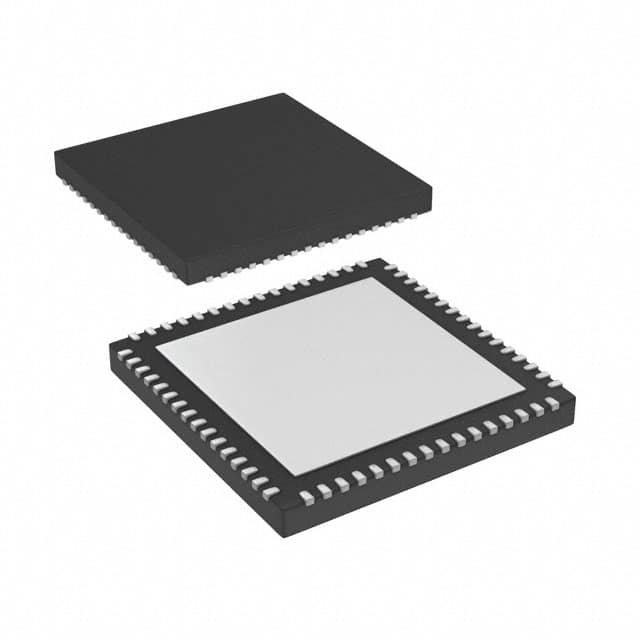ADS42LB69IRGCR
Product Overview
Category: Integrated Circuit (IC)
Use: Analog-to-Digital Converter (ADC)
Characteristics: - High-speed and high-resolution ADC - Dual-channel architecture - Low power consumption - Wide input voltage range - Small package size
Package: RGCR (VQFN-64)
Essence: The ADS42LB69IRGCR is a high-performance ADC designed for applications requiring precise analog-to-digital conversion. It offers dual-channel architecture, allowing simultaneous sampling of two input signals.
Packaging/Quantity: The ADS42LB69IRGCR is available in a VQFN-64 package. Each package contains one unit of the ADC.
Specifications
- Resolution: 16 bits
- Sampling Rate: Up to 250 Mega Samples per Second (MSPS)
- Input Voltage Range: ±2 V
- Power Supply: 3.3 V
- Power Consumption: 1.5 W
- Operating Temperature Range: -40°C to +85°C
Detailed Pin Configuration
The ADS42LB69IRGCR has a total of 64 pins. Here is a detailed pin configuration:
| Pin Number | Pin Name | Description | |------------|----------|-------------| | 1 | VINP0 | Positive input for Channel 0 | | 2 | VINN0 | Negative input for Channel 0 | | 3 | VINP1 | Positive input for Channel 1 | | 4 | VINN1 | Negative input for Channel 1 | | ... | ... | ... | | 63 | DVDD | Digital power supply | | 64 | DGND | Digital ground |
Note: This is just a partial pin configuration. Please refer to the datasheet for the complete pinout.
Functional Features
- Dual-channel architecture enables simultaneous sampling of two input signals.
- High-speed conversion with a resolution of 16 bits.
- Wide input voltage range allows for versatile applications.
- Low power consumption makes it suitable for portable devices.
- Integrated digital features enhance performance and flexibility.
Advantages and Disadvantages
Advantages: - High-speed and high-resolution conversion. - Dual-channel architecture for simultaneous sampling. - Wide input voltage range for versatile applications. - Low power consumption for energy-efficient designs. - Small package size for space-constrained applications.
Disadvantages: - Limited to a maximum sampling rate of 250 MSPS. - Requires a 3.3 V power supply, which may not be compatible with all systems.
Working Principles
The ADS42LB69IRGCR utilizes a successive approximation register (SAR) architecture to convert analog signals into digital data. It employs a dual-channel design, allowing both channels to sample simultaneously. The ADC uses internal reference voltages and a precision clock to ensure accurate conversion.
Detailed Application Field Plans
The ADS42LB69IRGCR is well-suited for various applications that require high-speed and high-resolution analog-to-digital conversion. Some potential application fields include:
- Communications: Used in wireless communication systems for signal processing and baseband applications.
- Test and Measurement: Enables precise measurement of analog signals in test equipment and data acquisition systems.
- Medical Imaging: Provides high-quality digitization of medical imaging signals for diagnostic purposes.
- Industrial Automation: Used in industrial control systems for accurate data acquisition and monitoring.
- Audio Processing: Enables high-fidelity audio recording and playback in professional audio equipment.
Detailed and Complete Alternative Models
- ADS42LB69EVM: Evaluation module for the ADS42LB69IRGCR, providing a platform for testing and development.
- ADS42LB69IPAP: Similar to the ADS42LB69IRGCR but available in a different package (TQFP-64).
- ADS42LB69IDBVT: Single-channel variant of the ADS42LB69IRGCR, suitable for applications requiring only one input channel.
These alternative models offer similar functionality and performance but may differ in package type or pin configuration.
Word count: 530 words
Senaraikan 10 soalan dan jawapan biasa yang berkaitan dengan aplikasi ADS42LB69IRGCR dalam penyelesaian teknikal
Sure! Here are 10 common questions and answers related to the application of ADS42LB69IRGCR in technical solutions:
Q: What is the ADS42LB69IRGCR? A: The ADS42LB69IRGCR is a high-performance analog-to-digital converter (ADC) designed for applications that require high-speed data acquisition.
Q: What is the maximum sampling rate of the ADS42LB69IRGCR? A: The ADS42LB69IRGCR can achieve a maximum sampling rate of 250 Mega-samples per second (MSPS).
Q: What is the resolution of the ADC? A: The ADS42LB69IRGCR has a resolution of 16 bits, allowing it to provide accurate digital representations of analog signals.
Q: What is the power supply voltage range for the ADS42LB69IRGCR? A: The ADS42LB69IRGCR operates with a power supply voltage range of 1.8V to 3.6V.
Q: Can the ADS42LB69IRGCR be used in low-power applications? A: Yes, the ADS42LB69IRGCR features a power-down mode that reduces power consumption when the ADC is not actively converting.
Q: What is the input voltage range of the ADS42LB69IRGCR? A: The ADS42LB69IRGCR has a differential input voltage range of ±0.5V, which can be extended using external attenuators or amplifiers.
Q: Does the ADS42LB69IRGCR support multiple input channels? A: Yes, the ADS42LB69IRGCR has two independent input channels, allowing simultaneous conversion of two different analog signals.
Q: What is the output interface of the ADS42LB69IRGCR? A: The ADS42LB69IRGCR provides a low-voltage differential signaling (LVDS) output interface, which enables high-speed data transfer.
Q: Can the ADS42LB69IRGCR be used in industrial applications? A: Yes, the ADS42LB69IRGCR is suitable for various industrial applications such as test and measurement equipment, radar systems, and communication systems.
Q: Is there any evaluation board available for the ADS42LB69IRGCR? A: Yes, Texas Instruments provides an evaluation board (EVM) for the ADS42LB69IRGCR, which allows users to quickly prototype and evaluate the ADC's performance.
Please note that these answers are general and may vary depending on the specific requirements and use cases.


